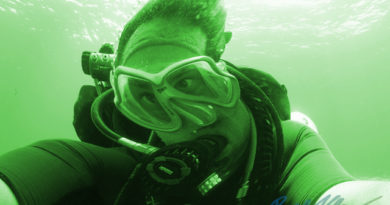A Frank Guide to Underwater Bodily Functions
None of us here are repressed prudes, so let’s frankly talk about bodily functions underwater. The human body is an open system which needs an input of energy and water, and which in turn needs to expel the end products of its metabolism. Sometimes things go wrong, too, and these liquids and solids go the wrong way – you have to throw up. It can also happen that you need to sneeze during a dive. If you spend a lot of time diving, some of these processes will happen to your body underwater once in a while.
So, let’s look at these popular bodily functions, one-by-one:
Urinating – Drinking – Eating – Defecating – Sneezing – Puking
Urinating
A classic. “There are divers who pee in their wetsuits, and those who don’t admit it” or so the saying goes. It is not surprising that the urge to urinate underwater is strong, and it is only natural that divers give in to the urge. Why is that the case?
When a mammal, like a human, is underwater, the mammalian diving reflex sets in. The reflex will cause diuresis and excretion of sodium and potassium – the kidneys will increase their activities, the bladder will fill, and the urge to urinate will grow. One possibility to avoid submarine urination would be to drink less before the dive, but that would be a big mistake: proper hydration is recognized as a major factor in reducing the risk of bubble formation and decompression sickness (for example see here). Not drinking to spare yourself the awkwardness of having to pee underwater would increase one of the health risks of diving.
And, it’s not a problem to pee on yourself while underwater! Urine will wash off quickly, and has no bacteria. The right exposure protection is key:
– In the tropics, I dive in board shorts or “tec shorts”, neoprene pants with pockets. Very urination-friendly.
– If you are wearing a full wet suit, the urine will stick with you for a while. Pulling the wetsuit at your ankles or at your collar will flush fresh water into the wetsuit, and urine out. Try to do this not right before you climb back onto your dive boat, so that the pee had a chance to flow out of your suit.
– More complicated: urinating while dry suit diving. I used to dive dry in Australia, and I held it in. The dives I did were never so long that this was a problem. In case one plans lengthy decompression dives in a dry suit, special gadgetery is necessary, and the solutions will be different depending if you are male or female.
This thread on Schubaboard has some information on the possible solutions for women. And this one for men. None of the options sound like great fun to implement. I don’t want to have to put rubber contraptions over my little best friend on a parking lot before a dive. But it’s still better than freezing every minute of your dive if you dive in cold or temperate waters (by wearing a wetsuit), or diving with the unpleasant feeling of having to urinate.
Why is it not ideal to just control the urge to urinate? For a short while, with a moderately strong urge, that is ok. But, the feeling will inevitably distract you, and it might distract you from running your deco schedule, taking good pictures, looking where your buddy is, or doing some scientific sampling. Task loading is the keyword here. And it’s simply not enjoyable!
Drinking
Doable, and a good idea during long dives. Dehydration can increase the chances for decompression sickness, as pointed out above.
The convenient “camel back” type water containers, with a hose and a mouth piece which opens when biting on it, is used by tec divers during very long dives. I have not used this system underwater yet, but am considering it. It’s sold at any camping store, and easy to add to your diving kit. Naturally, you have to take the regulator out of your mouth, and not breathe while drinking. Not breathing for a few seconds is no problem for a healthy adult, but if you are a newby diver and your airway control is not so great yet, be careful! You are breathing through your mouth on a dive, the same orifice the drink goes in, and you don’t want to accidentally inhale sea water or your drink. You’ll have to be much more conscious of what you are doing, even during such a simple act as drinking …. I’d certainly practice underwater drinking a few times just below the surface the first time you use your scuba drinking system.
Not that kind of drinking of course. You can also practice that, but after the dive please:
Eating
Even during very long dives, one will be able to go without food, and you can always put a sugary sports drink into your drinking container, if you want to replenish your energy. It’s still possible to eat while on a dive, though. I haven’t tried eating underwater, but I have seen DMs pick off edible algae, and eat them, as a stunt for their diving guests.
I guess if you are a really, really hungry person, and you are doing a very long dive, you could bring along chocolate bars or something of that consistency. Airway control is again the key.
Spinach puree: Maybe not the ideal underwater meal.
Defecating
I’ve done it twice underwater. I can’t recommend it. Why did I still do it? It happened once in Gillimanuk/Bali, and once in Apo Island/Philippines, both tropical locations. In the tropics it’s hot (duh!), and bacteria grow faster, including the baaaad bacteria which sometimes live on your food. The ones which sometimes causes intestinal infections and explosive diarrhea. Baaaaaad bacteria!
Tip: Don’t even go diving when you are suffering from the aforementioned explosive diarrhea. You will be weakened, and dehydrated. The dehydration, as mentioned above, can increase your DCS risk. Note: Do as I say, not as I do.
On that intestinally challenged afternoon a few years ago I really wanted to see the famous reefs of Apo Island, despite being having been already diarrheatically challenged for two days. The dive itself was uneventful and interesting- Apo is an awesome dive site with a healthy coral cover ad a very diverse fish fauna. I was swimming along the reef with my photographer friend, when then the urge to evacuate simply became too much. I swam very quickly away from my friend and his camera, and found a big coral bommie to hide behind. There I pulled down my shorts, and the rest is scuba diving history.
Here the right type of exposure protection was absolute key! No exposure protection was the key, to be precise.
I was wearing only a pair of board shorts – which are easy to pull own in a mere seconds. Wetsuit: not so good. Drysuit: hygienic catastrophe & XXL embarrassment.
What happened to the expelled digestive end-products? The fish ate it. I didn’t stick around to watch, but I had the chance to observe the tropical marine fish fauna’s enthusiasm for human excrement a few years earlier. Then, I had dived in Egypt, with a friend who was also suffering from an acute intestinal aliment at the time. He juuust made it back onto the dive boat, and headed straight for the toilet. It was a marine toilet, so the material went right out of the boat, into the ocean right above myself and a group of my friends who were doing our safety stop at 5 meters, as one does.
Damselfish of the genus Abudefduf came to feast on the feces with great zest. They went on a real feeding frenzy.
I realized what was going on and decided to do my safety stop a little bit deeper that day.
Two of my other friends did not realize the source of the fish’s feeding frenzy, and stayed on to watch. One of them even commented on the spectacle after the dive. I had to explain to him what had upped the Abudefduf’s activity levels.
In fact, eating poo-poo is a well known feeding strategy among fishes. Smaller fish eat what mid-sized predators like barracudas shit out, since these carnivores feed on high-quality food but don’t digest all its nutrients in their relatively short digestive systems. The barracuda feces still contain a lot of nutrients. The episode I witnessed was likely not the damselfish’s first feces lunch.
I am not making any of this up!!
Sneezing
Underappreciated, but also potentially tricky. This has happened to me a few times. Normally, when breathing from a tank of compressed air, a diver would not get any sneeze-inducing dust particles or hairs up one’s nose. I must have started the dive with an incessant urge to sneeze, which then built up in the first minutes of the dive.
Keep cool, maintain airway control, don’t spit out your regulator, don’t inhale water after the sneeze.
Puking
Yep, that happens, too. Again, not recommend but sometimes unavoidable. Sea-sickness is something which comes with rocky boat rides over rough oceans, but it fortunately subsides very quickly when one jumps into the water, off the rocking boat. It’s more likely that an upset stomach is the cause of the uncontrollable urge to get rid of one’s lunch by throwing up. So far I twice had the misfortune of a submarine puke.
Again, airway control is the key skill here. You can puke with your regulator in your mouth, then the liquid and semi-digested food particles will pass through it the way the air normally vents. You can also take the regulator out – that’s the advanced version. The key is not to lose control over your breathing during the puke, and not to inhale water in the moments afterwards.
Gargling a bit of sea-water post-puke will remove the bulimia-esque aroma from your mouth.
Happy diving! And let’s hope you’ll make it back to the surface with only a pleasant pee and maybe a rehydrating drink.
Like my description of bodily functions underwater? Then you should like my description of extreme brain states (if you can read German!):


